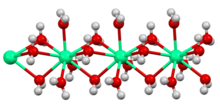User:InterstellarGamer12321/Calcium compounds

The chemistry of calcium is that of a typical heavy alkaline earth metal. For example, calcium spontaneously reacts with water more quickly than magnesium and less quickly than strontium to produce calcium hydroxide and hydrogen gas. It also reacts with the oxygen and nitrogen in the air to form a mixture of calcium oxide and calcium nitride.[1] When finely divided, it spontaneously burns in air to produce the nitride. In bulk, calcium is less reactive: it quickly forms a hydration coating in moist air, but below 30% relative humidity it may be stored indefinitely at room temperature.[2]
Besides the simple oxide CaO, the peroxide CaO2 can be made by direct oxidation of calcium metal under a high pressure of oxygen, and there is some evidence for a yellow superoxide Ca(O2)2.[3] Calcium hydroxide, Ca(OH)2, is a strong base, though it is not as strong as the hydroxides of strontium, barium or the alkali metals.[4] All four dihalides of calcium are known.[5] Calcium carbonate (CaCO3) and calcium sulfate (CaSO4) are particularly abundant minerals.[6] Like strontium and barium, as well as the alkali metals and the divalent lanthanides europium and ytterbium, calcium metal dissolves directly in liquid ammonia to give a dark blue solution.[7]
Due to the large size of the calcium ion (Ca2+), high coordination numbers are common, up to 24 in some intermetallic compounds such as CaZn13.[8] Calcium is readily complexed by oxygen chelates such as EDTA and polyphosphates, which are useful in analytic chemistry and removing calcium ions from hard water. In the absence of steric hindrance, smaller group 2 cations tend to form stronger complexes, but when large polydentate macrocycles are involved the trend is reversed.[6]
Although calcium is in the same group as magnesium and organomagnesium compounds are very commonly used throughout chemistry, organocalcium compounds are not similarly widespread because they are more difficult to make and more reactive, although they have recently been investigated as possible catalysts.[9][10][11][12][13] Organocalcium compounds tend to be more similar to organoytterbium compounds due to the similar ionic radii of Yb2+ (102 pm) and Ca2+ (100 pm).[14]
Most of these compounds can only be prepared at low temperatures; bulky ligands tend to favor stability. For example, calcium dicyclopentadienyl, Ca(C5H5)2, must be made by directly reacting calcium metal with mercurocene or cyclopentadiene itself; replacing the C5H5 ligand with the bulkier C5(CH3)5 ligand on the other hand increases the compound's solubility, volatility, and kinetic stability.[14]
See also
[edit]References
[edit]- ^ C. R. Hammond The elements (pp. 4–35) in Lide, D. R., ed. (2005). CRC Handbook of Chemistry and Physics (86th ed.). Boca Raton, Florida: CRC Press. ISBN 0-8493-0486-5.
- ^ Hluchan and Pomerantz, p. 483
- ^ Greenwood and Earnshaw, p. 119
- ^ Greenwood and Earnshaw, p. 121
- ^ Greenwood and Earnshaw, p. 117
- ^ a b Greenwood and Earnshaw, pp. 122–15
- ^ Cite error: The named reference
Greenwood112was invoked but never defined (see the help page). - ^ Greenwood and Earnshaw, p. 115
- ^ Harder, S.; Feil, F.; Knoll, K. (2001). "Novel Calcium Half-Sandwich Complexes for the Living and Stereoselective Polymerization of Styrene". Angew. Chem. Int. Ed. 40 (22): 4261–64. doi:10.1002/1521-3773(20011119)40:22<4261::AID-ANIE4261>3.0.CO;2-J. PMID 29712082.
- ^ Crimmin, Mark R.; Casely, Ian J.; Hill, Michael S. (2005). "Calcium-Mediated Intramolecular Hydroamination Catalysis". Journal of the American Chemical Society. 127 (7): 2042–43. doi:10.1021/ja043576n. PMID 15713071.
- ^ Jenter, Jelena; Köppe, Ralf; Roesky, Peter W. (2011). "2,5-Bis{N-(2,6-diisopropylphenyl)iminomethyl}pyrrolyl Complexes of the Heavy Alkaline Earth Metals: Synthesis, Structures, and Hydroamination Catalysis". Organometallics. 30 (6): 1404–13. doi:10.1021/om100937c.
- ^ Arrowsmith, Merle; Crimmin, Mark R.; Barrett, Anthony G. M.; Hill, Michael S.; Kociok-Köhn, Gabriele; Procopiou, Panayiotis A. (2011). "Cation Charge Density and Precatalyst Selection in Group 2-Catalyzed Aminoalkene Hydroamination". Organometallics. 30 (6): 1493–1506. doi:10.1021/om101063m.
- ^ Penafiel, J.; Maron, L.; Harder, S. (2014). "Early Main Group Metal Catalysis: How Important is the Metal?". Angew. Chem. Int. Ed. 54 (1): 201–06. doi:10.1002/anie.201408814. PMID 25376952.
- ^ a b Greenwood and Earnshaw, pp. 136–37
